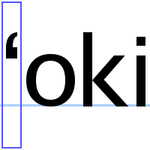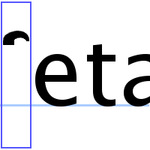- ʻOkina
-
This article is about the letter. For the Rurouni Kenshin character, see List of Rurouni Kenshin characters#Okina.
ʻOkina letter forms 
The Tongan fakauʻa letter or Hawaiian ʻokina encoded as U+02BB (in Unicode[1]), derived from the Lucida Sans font. 
The Tahitian ʻeta letter (or Wallisian fakamoga), currently not encoded correctly, derived from the Lucida Sans font. The ʻokina, also called by several other names (see examples below), is a unicameral consonant letter used within the Latin script to mark the phonetic glottal stop, as it is used in many Polynesian languages.
Area Vernacular name Literal meaning Notes Hawaiian ʻokina separator transitionally formalized Tongan fakauʻa
(honorific for fakamonga)throat maker officially formalized Wallisian (in ʻUvea) fakamoga by throat no official or traditional status, may use ' or ‘ or ’ Tahitian ʻeta ʻetaʻeta = to harden no official or traditional status, may use ' or ‘ or ’ Cook Islands Maori ʻamata or ʻakairo ʻamata "Hamsah" or "Hamsah mark" no official or traditional status, may use ' or ‘ or ’ or nothing Samoan koma liliu "inverted comma"—inverted (liliu) comma (koma) often replaced by an apostrophe in modern publications, recognized by Samoan scholars and community.[2] Contents
Geographic names in the United States
In 1995 the United States Board on Geographic Names began changing its longtime policy and is now using ʻokina and kahakō in the Geographic Names Information System.[3]
Encoding and displaying the Polynesian glottal
Old conventions
In plain ASCII the glottal is sometimes represented by the apostrophe character ('), ASCII value 39 in decimal and 27 in hexadecimal, which in most fonts currently used renders as a straight, data-processing, typewriter apostrophe as is also specified in Unicode. But in some older fonts, especially those used on Unix-like platforms and related platforms and on an MS-DOS screen, it renders as a right single quotation mark (which is the wrong shape).
A "hypercorrect"[citation needed] (that is, incorrect) method for plain ASCII text is to use U+0060 grave accent (`) (called a "back-quote" character), which in some older fonts does display a glyph similar to a left single quotation mark. However, in most newer fonts, it has a pronounced lean to the left and can look inappropriate. A (partial) advantage is when a wordlist is alphabetically sorted, the "`" often comes after the "z", exactly where it should be in the Tongan language (admittedly not so in most other Polynesian languages, where it should be ignored). It is still useful as a fallback when words are to be entered into a database with limited character-set ability to have the character distinct from the apostrophe.
The new standard and transitional problems
According to Unicode, the codepoint for ʻokina is Unicode character U+02BB MODIFIER LETTER TURNED COMMA ( ʻ ) which can be rendered in HTML by the entity
ʻ(or in hexadecimal formʻ).[1]Lack of support for this character in older fonts (and many newer fonts), along with the large amount of legacy data and expense in time and money to convert, has prevented easy and universal use of the new character. As of 2008[update] Apple Mac OS X and Microsoft Windows based computers have no problem with the glyph, and it is no longer a problem in Internet Explorer 7 as it was in previous versions. U+02BB should be the value used in encoding new data when the expected use of the data permits.
This character is also a proper one for a Latin-letter transliteration of the Hebrew letter ʻáyin and the Arabic letter ʻayn. They are sometimes also rendered by a superscript half ring with the opening to the right ( ʿ ) or even, as a typographical fallback, a superscript c ( c ).
Unicode encodes a glottal stop at U+02C0 MODIFIER LETTER GLOTTAL STOP (ˀ), but this is intended for IPA usage, and is inappropriate for ʻokina.
Its orientation and curve should not depend on the font style for apostrophes (so using a left apostrophe is wrong too, because it can be drawn either like a superscript non-curved mirrored comma, or a superscript 6-shaped apostrophe).
Texts written natively in some Polynesian languages[clarification needed][verification needed] draw the glottal stop very differently, looking like none of the apostrophe, mirrored apostrophe, turned comma, or accent letter. This letter is more like a 9-shaped left apostrophe, turned about 60 to 90 degrees counter-clockwise.
Tentative approximations
A display work-around
Because this character is not found in many fonts, it may not appear properly on all computer systems and in all configurations. Accordingly, where U+02BB should properly be used, the Unicode punctuation character U+2018 LEFT SINGLE QUOTATION MARK, ‘, represented by the HTML entity
‘, is sometimes used instead. It is nearly identical in appearance to U+02BB, but is treated as a punctuation mark rather than a letter by applications.In practical terms, this only matters with regard to page breaks, hyphenation, and capitalization; these usually cause few problems. This symbol is also used instead of the recommended turned comma letter symbol in transliterations from Semitic languages to ensure proper display on the widest number of browsers.
The problem with this left single quotation mark character is that, depending on font style design, the single quotation mark may have two very different shapes, one of which is incompatible with the okina:
- a superscript straight mirrored comma, drawn from bottom to top and normally thicker on the bottom right than on the top left. The thicker end on the bottom is incompatible.
- the modifier letter turned comma, but it may still be wrong as it could be drawn in some font designs as an oblique straight line or a wedge without the needed curve, or the curve will be made so that its center will be on the left or top right, when the okina curve should be centered and opened on the bottom or bottom left.
A work-around problem
Nowadays many word processors are equipped with "smart quotes", which automatically change the straight apostrophe (') and the straight quotation mark (") into curly ones. If a quotation mark occurs after a space, it is assumed to be an open quote (the left quote), if elsewhere a close quote (the right quote). This policy also allows the apostrophe to be dealt with in the same way. Clearly this is not the behaviour one wants for the glottal. One would end up with text full with "drunken" glottals, some pointing left, some pointing right. If a special Polynesian keyboard layout is not available, a workaround to the workaround is to insert a "dummy" space before typing the quote (thus making it a left, open quote), then delete the space.
Also standard undo function of the word processors removes the bad autocorrections, for example using the undo icon on the toolbar or pressing CTRL-z in the most widely spread office suites, after the autocorrection happens.
Use of apostrophe
In some sans-serif fonts non-bolded and at normal size, the left single quotation character does not appear distinctly different from the straight apostrophe or from the right single quotation character. In Hawaiian, where only one of these curly quotation forms is used as a letter, this matters little. It is more problematic in displaying transliterations from Semitic languages where both left- and right-facing characters are used with different meanings. However, according to Kualono, in reference to the ʻokina and kahakō, "though native speakers of the past and even those still living did not use them, it is a great help to those learning Hawaiian as a second language. Their use is now accepted as standard in the written form of the language by all university and private offices involved in Hawaiian language education. To omit the 'okina and kahako in print or in computer representations of the language is to do the language a great injustice, and we consider this omission of the ʻokina and kahakō in words where they do exist to be a misspelling of those words. Until the past 8 to 10 years there were no tools for properly and easily representing the ʻokina and kahakō on the computer. With the availability of the tools on this website and available from commercial developers, there is no longer an acceptable excuse for not using the ʻokina and kahakō."[1]
See also
References
- ^ a b Unicode Standard 5.1
- ^ Hunkin, Galumalemana Afeleti (2009). Gagana Samoa: A Samoan Language Coursebook. University of Hawaii Press. p. xiii. ISBN 0-8248-3131-4. http://books.google.co.nz/books?id=mnIg9rH97_UC&pg=PA122&lpg=PA122&dq=Samoan+language+word+order&. Retrieved 17 July 2010.
- ^ U.S Board on Geographic Names: Collection and Dissemination of Indigenous Names (United Nations Group of Experts on Geographical Names, Twenty-third Session Vienna, 28 March – 4 April 2006, Working Paper No. 82), S. 3: "An example of this has been the addition of the glottal stop (okina) and macron (kahako) to placenames of Hawaiian origin, which prior to 1995 had always been omitted. The BGN staff, under the direction and guidance of the Hawaii State Geographic Names Authority, has been restoring systemically these marks to each Hawaiian name listed in GNIS."
External links
- The correct Unicode values and HTML entities for Hawaiian in Unicode
- Apple Compatibility with Hawaiian added in OS 10.2
- Apple Computer Includes Hawaiian Language Support With Latest Operating System.
- Honolulu Advertiser (September 2, 2002): I mua! Macintosh 'speaks' Hawaiian
- Starbulletin (September 16, 2002): Macs upgrade to isle punctuation
- SFGate (September 9, 2002): Hawaiian language advocates applaud new Mac operating system.
- Honolulu Advertiser (June 28, 2004): Hawaiian spellings catch on, but slowly. (On slow progress in using proper Hawaiian spellings instead of makeshift English spelling.)
- Ulukau: The Hawaiian Electronic Library: Browser information for viewing Hawaiian characters
- The Okina in French Polynesian, a graphic example on the top of the page of the official website of the commune of Faa'a, capital of the French Polynesia (this explains why the INSEE still encodes it like the French apostrophe).
Aa Bb Cc Dd Ee Ff Gg Hh Ii Jj Kk Ll Mm Nn Oo Pp Qq Rr Ss Tt Uu Vv Ww Xx Yy Zz RelatedCategories:- Languages of Oceania
- Hawaiian English
- Uncommon Latin letters
Wikimedia Foundation. 2010.
